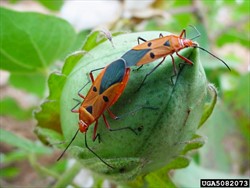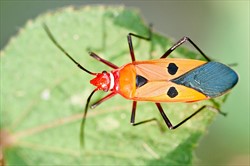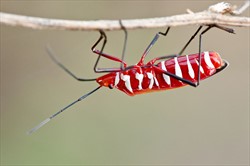Cotton stainers and pale cotton stainers.
Pacific Pests, Pathogens, Weeds & Pesticides - Online edition
Pacific Pests, Pathogens, Weeds & Pesticides
Cotton stainers (555)
Dysdercus species. Several species have been recorded from Oceania; the most widespread are the cotton stainers, Dysdercus cingulatus, and the pale cotton stainer, Dysdercus sidae. They are members of the Pyrrhocordiae.
Africa, Asia, North, South and Central America, the Caribbean, Europe (restricted), Oceania. They are recorded from Australia, Federated States of Micronesia, Fiji, New Caledonia, Northern Mariana Islands, Palau, Papua New Guinea, Samoa, Solomon Islands, Timor-Leste, Tonga, and Vanuatu.
Cotton, and other members of the Malvaceae family, such as Abelmoschus esculentus (okra), Abutilon, Hibiscus, Sida, as well as members of other plant families, e.g., kapok (Bombacaceae), Pennisetum, Sorghum, maize and wheat (Poaceae), and citrus (Rutaceae). Wild Malvaceae and some forest trees are hosts.
Adults and nymphs suck juices from seeds of, e.g., cotton bolls and okra pods (Photos 1&2). On cotton, seeds punctured either before the boll opens or after, may wither and die, leading to boll shedding or, where damage is less, the lint may not expand properly, a condition known as 'tightlock'. Microorganisms may be injected at feeding resulting in boll rots and discolouration of the lint (hence the name 'stainer'). The staining may also result from the discharge of watery faeces. On okra, the feeding may causes small, dark, raised blister-like spots on the pods.
Eggs (about a 100) are laid in batches in soil or leaf litter under host plants. There are five nymph stages over about 30 days. From the third stage onwards, the nymphs can pierce the boll and feed on the seeds. Adults, about 15 mm long, have a red and black head, red eyes, and pink to orange body, with a small black dot on each forewing (Photos 1,3&4). A white line ('collar') is present between head and thorax, and several present along the sides of the thorax, and possibly the abdomen in some species (Photo 5).
Spread is from adults flying from weed hosts or crops. Flights of up to 15 km have been recorded.
Cotton stainers and pale cotton stainers can severely damage cotton. There is potential for seed to be damaged (reduced weight, oil content, viability), lint may not expand properly, or it may become stained. However, economic impact is usually low. Broad-spectrum insecticides are often used for the control of other insects, and because cotton stainers do not survive high temperatures (above 40oC), damage is probably not economically significant. The impact of Dysdercus species on other crops, e.g., on okra has not been detailed. In Australia Dydercus sidae is known to damage ripening peaches.
Indirect damage to bolls is also possible due to secondary infections of fungi following feeding of cotton stainers.
Look for (true) bugs about 15 mm long, red head, white line between ahead and thorax, white lines along the sides of the body, a single black spot on each wing, and long beak-like mouth parts used to suck nutrients from seeds in the boll (cotton), and pod (okra).
BIOSECURITY
In Australia, cotton stainers are considered a high priority risk pest of cotton with several American species specifically named as pests of concern. Volonteer and ratoon cotton is considered a risk to establishment of exotic pests. Prevention of cotton stainers spreading internationally may necessitate cargo being fumigated at the point of origin where the bugs are known to be a problem.
BIOLOGICAL CONTROL
Potential candidates, e.g., the fungus Poecilomyces species, the pyrrhocorid predator, Antilochus conquebertii, reduvid (assassin) bugs and Tachinid flies are known, but investigations have not led to biological control programs.
CULTURAL CONTROL
Before planting:
- Plough deeply or hoe to expose the eggs.
- Remove weeds (especially mallows and hibiscus in the Malvaceae), and hosts trees, e.g., kapox, before planting.
During growth:
- Hand pick and destroy the bugs; this is most effective in small plots and done at the beginning of infestations.
- Alternatively, place a clear plastic bag over the developing okra pods (similarly for cotton buds), and make small holes in the plastic.
- Cage chickens in cotton or okra plots; about 15 birds will keep about 0.1 ha free of stainer bugs.
After harvest:
- Collect the remains of the crops and all debris as soon as harvesting is complete.
- Destroy wild alternate hosts, and volunteer crop plants.
CHEMICAL CONTROL
In Australia, the synthetic pyrethroid, lambda-cyhalothrin is recommended using an action threshold of three cotton stainer bugs per metre. Pyrethum is also recommended in African countries for smallholder use.
______________
When using a pesticide, always wear protective clothing and follow the instructions on the product label, such as dosage, timing of application, and pre-harvest interval. Recommendations will vary with the crop and system of cultivation. Expert advice on the most appropriate pesticides to use should always be sought from local agricultural authorities.
AUTHOR Grahame Jackson
Information from Stehlik JL (1965) Pyrrhocoridae and Largidae collected by E.S. Brown on Solomon Islands (Heteroptera). Časopis Moravského muzea. Vědy přírodní 50: 253-291; and Cotton stainer bugs (Pyrrhocordidae). (https://sown.com.au/pyrrhocoridae-cotton-stainer-bugs/); and Wilson L (2008) Pale cotton stainers, Dysdercus sidae. On Farm Series: IPM. Cotton Catchment Communities CRC. (http://www.insidecotton.com/xmlui/bitstream/handle/1/127/Cotton_Stainer.pdf?sequence=1&isAllowed=y); and from CABI (2021) Dysdercus cingulatus (red cotton stainer). Crop Protection Compendium. (https://www.cabidigitallibrary.org/doi/10.1079/cabicompendium.20225). Photo 1 Red cotton bug (Dysdercus cingulata) Fabricius. O.P. Sarma, Bugwood.org. Photos 3&5 Rushenb. Dysdercus Cingulatus-Fabricius, Red cotton stainer bug. Kaeng Krachan National Park. Photo 4 gailhampshire from Cradley, Malvern, UK. Pale cotton stainer bug. Pyrrhocoridae. Photos 4-6 Pita Tikai Kastom Gaden Association. Honiara, Solomon Islands
Produced with support from the Australian Centre for International Agricultural Research under project HORT/2016/185: Responding to emerging pest and disease threats to horticulture in the Pacific islands, implemented by the University of Queensland and the Secretariat of the Pacific.








